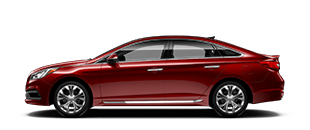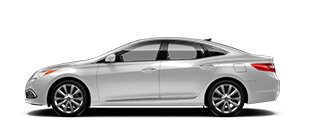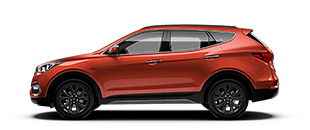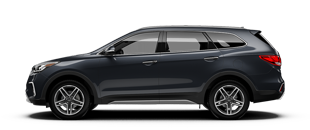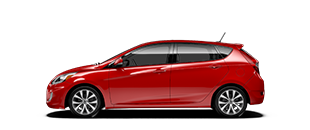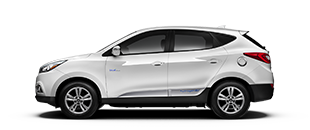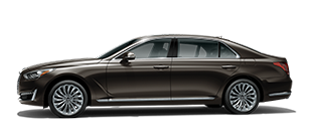DRIVE THE WORLD’S FIRST MASS-PRODUCED
FUEL CELL COMPACT SUV.
Fuel cell technology that’s on the road now.
As the first mass-produced fuel cell vehicle and the first Compact SUV to ever offer fuel cell technology, the Tucson Fuel Cell is one of the most futuristic vehicles on the road today. While it performs just as strongly as an internal combustion engine, its only emission is water. And it’s just as quiet as a standard EV, while going farther on a single fuel fill-up versus a single full charge.
The amazing 2016 Tucson Fuel Cell
- • Free Fuel
- • Free Concierge Maintenance
- • HOV Lane Access
Meet everyday superheroes. Powered by fuel cell.
They are among us. Hidden in plain sight, boldly changing the world. They look like us. They drive like us. Their superpower: the fuel cell. Indeed, no one could possibly guess that hiding beneath the hood of this appealing Compact SUV lies what is potentially the most revolutionary fuel source on Earth.
Learn more about these everyday superheroes and the extremely efficient, environmentally friendly Compact SUV they drive.
place, day after day, mile after zero-emission mile.
Where to fill up now and down the road.
Highlights
Wrap yours in sustainable style.
These two new vehicle wraps are a beautiful way to draw attention to the Tucson Fuel Cell’s benefits for the environment and your pioneering spirit. Choose from two wrap designs: The Wave themed wrap is available with all vehicle colors, while the Topography themed wrap is only available on Winter White and Chromium Silver vehicles. And best of all, the wrap and installation are included at no additional cost. Just select your preference when you fill out your driver’s application. Want to go incognito? That’s OK, just mark your choice on the application.
Why the Tucson Fuel Cell is a better choice than Toyota Mirai?
Safety: Another essential element.
The Tucson Fuel Cell has passed numerous on-road tests for safety and durability conducted over an accumulated distance of 2 million miles. Plus, with features like its high-strength carbon fiber-wrapped fuel tank and several safety systems designed to protect passengers and first responders, the Tucson Fuel Cell is as safe as any vehicle on the road.
Welcome to driving solo in the HOV lanes.
While the Tucson Fuel Cell’s motor performs just as strongly as an internal combustion engine, its only emission is water. And it’s just as quiet as a standard EV, while going farther on a single fuel fill-up versus a single full charge. Plus, the Tucson Fuel Cell qualifies for federal rebates and you can register it to drive solo in HOV lanes.
Who has time to wait?
265 miles on one tank. Gotta love that.
Tucson Fuel Cell sets a new world record.
Specifications


Powertrain
Performance
**EPA estimate.
How It Works
Smooth, silent power in an instant. None of the emissions.
-
1.The hydrogen fuel stored in its tank is supplied to the fuel cell stack.
-
2.Inflow of air is supplied to the fuel cell stack.
-
3.The reaction of air and hydrogen in the fuel cell stack generates electricity and water.
-
4.The electricity generated is supplied to the motor and battery.
-
5.What comes out after all of this?
Pure water.
FAQs: Answers on demand
-
When will the Tucson Fuel Cell be available?
The Tucson Fuel Cell is currently being leased in select areas in California. It will be available in other regions as fueling infrastructure becomes available.
-
How much does the Tucson Fuel Cell lease cost?
The Tucson Fuel Cell is only available for a 36-month lease, $499 per month and $2,999 due at lease signing. This will include all maintenance, fuel, carpool lane access, and “At Your Service” concierge service for regularly scheduled complimentary maintenance and vehicle service.
-
Is it possible to purchase the Tucson Fuel Cell?
No, at this time the vehicle is only available for lease. In addition, there is no purchase option at the end of the lease.
-
Where do I have to live in order to lease a Tucson Fuel Cell?
The Tucson Fuel Cell will initially be available only in select areas in California due to the current availability of public hydrogen refueling stations. In the future, the Tucson Fuel Cell will be available in other areas as public refueling infrastructure expands beyond select areas in California. Please refer to Hyundai.com for vehicle availability by zip code.
-
How and when can I place an order for the Tucson Fuel Cell?
Due to limited vehicle availability and an emerging refueling infrastructure, anyone interested in leasing the Tucson Fuel Cell should go to Hyundai.com and enter their name, email address and zip code. An application will be made available to those who sign up. The names of those who qualify will be placed in a drawing which will take place near the vehicle launch date.
-
How far can you drive on one fill-up in the Tucson Fuel Cell?
The Tucson Fuel Cell has an estimated driving range of approximately 265 miles depending on driving conditions.
-
How long does it take to fill up the Tucson Fuel Cell?
Refueling with hydrogen is similar to refueling a conventional gasoline powered vehicle. The Tucson Fuel Cell is capable of refueling from empty in less than 10 minutes.
-
What happens if I run out of fuel in the Tucson Fuel Cell?
If the vehicle runs out of fuel, it will need to be towed on a flatbed to the nearest refueling station.
-
Are there any special maintenance requirements for the Tucson Fuel Cell?
No, servicing the Tucson Fuel Cell is similar to the conventional vehicle. Typical items include servicing the brakes, replacing the cabin air filter, replacing the coolant, etc.
-
What impact does the Tucson Fuel Cell leave on the environment?
The Tucson Fuel Cell does not emit any harmful greenhouse gas emissions such as carbon dioxide. Instead, water is the only emission.
-
How long has the fuel cell technology been around?
Although fuel cells sound like a modern innovation, the first fuel cell was developed in the 1840s. NASA became the first to put fuel cells in use with the Gemini and Apollo spacecrafts, Skylab and the Space Shuttles. In the 1960s, auto companies began working with fuel cells in vehicles. Over the decades, fuel cells have become smaller, more powerful and longer lasting.
-
What other features help make the Tucson Fuel Cell more efficient?
The Tucson Fuel Cell is equipped with a stop/start mode that shuts down the fuel cell stack and uses battery power when idling, minimizing energy loss in city driving. Additionally, the high-voltage battery is charged by the electric motor while braking, in Regeneration mode.
-
What makes Hyundai’s Tucson Fuel Cell different from others?
Fuel cell technology is simple and there are many similarities among the various automakers’ fuel cell designs. The Hyundai fuel cell has one major difference compared to its competitors: The Hyundai fuel cell uses near ambient air pressure to provide oxygen to the fuel cell stack compared to fuel cell systems that use compressed air. Compressing air requires additional energy. Hyundai’s design results in low parasitic loss in the oxygen supply, which leads to high fuel efficiency and reduces power consumption by 50 percent. This setup also reduces noise in the cabin.
-
How safe is the Fuel Cell technology?
Hyundai Fuel Cell vehicles have been subjected to extensive safety testing, including destructive and non-destructive evaluations at the component, system and vehicle level. There are many internal safety mechanisms to ensure the safety of the vehicle. All Hyundai vehicles complete a rigorous crash test program before they are ever driven on public roads. The Tucson Fuel Cell has undergone crash tests for offset-frontal, side and rear impact, as well as fire tests. Also, there are several impact sensors. In event of a crash, the sensors stop the release of hydrogen from the tanks.
-
How safe is hydrogen?
Like any fuel, hydrogen requires proper handling and a safe system design for production, storage and usage. Hydrogen, if properly handled, is as safe as gasoline, diesel or natural gas—and in some instances even safer. For decades, hydrogen has been shipped and used safely in the United States for use in everything from welding to hydrogenated peanut butter. More than 70 million gallons of hydrogen are transported every year. Hydrogen is the most common element in the universe, and it’s also the lightest—even lighter than helium. This means that if there’s a leak in a storage tank, the hydrogen dissipates quickly into the air, without polluting.
-
Are the hydrogen storage tanks safe?
Yes, the tanks are very safe. There have been no reported cases of catastrophic failure of a storage tank. If a leak occurs, there is almost no risk of explosion because hydrogen is lighter than air and rises immediately, minimizing the risk of explosion. If the Tucson Fuel Cell is stored in an enclosed space, four onboard hydrogen sensors are designed to detect leaks and sound an alarm.
-
{{DealerName}}
{{Address1}}
{{City}}, {{State}} {{Zip}} ({{DistanceFromVisitor}} Miles)
{{SalesPhone}} {{LanguagesSpoken:join(' | ')}}{{DealerBadgesSmall}}
-
{{DealerName}}
{{Address1}}
{{City}}, {{State}} {{Zip}} ({{DistanceFromVisitor}} Miles)
{{SalesPhone}} {{LanguagesSpoken:join(' | ')}}{{DealerBadgesMedium}}
-
{{DealerName}}
{{Address1}}
{{City}}, {{State}} {{Zip}} ({{DistanceFromVisitor}} Miles)
{{SalesPhone}} {{LanguagesSpoken:join(' | ')}}
-
{{DealerName}}
{{Address1}}
{{City}}, {{State}} {{Zip}} ({{DistanceFromVisitor}} Miles)
{{LanguagesSpoken:join(' | ')}}
{{DealerName}}
{{Address1}}
{{City}}, {{State}} {{Zip}} ({{DistanceFromVisitor}} Miles)
{{SalesPhone}}
{{LanguagesSpoken:join(' | ')}}
- {{Description}} {{Distance}}
-
{{Name}}
{{DescriptionShort}}
-
{{ModelYear}} {{ModelName}}from ${{NicePrice}} MSRPExplore {{ModelName}} Get a dealer quote Build your own
-
{{Name}}
{{Description}}
Learn More






